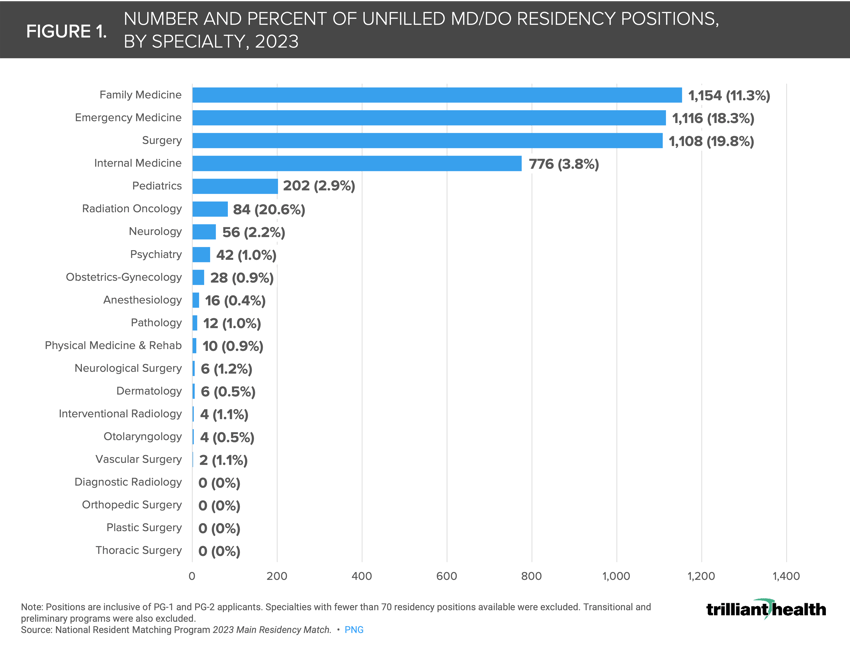Studies Archive
Primary Care and Emergency Medicine Have Highest Number of Unfilled Residency Positions
April 16, 2023Key Takeaways
-
Of the applicants with certified rank ordered match lists, 81.1% matched to a first-year residency position. Compared to 2022, the total number of available residency slots increased by 2.0% (747 positions).
-
The highest number of unfilled positions was concentrated in family medicine (1,154 positions unfilled) and the highest percentage of unfilled positions was in radiation oncology (20.6% of positions unfilled).
-
Emergency medicine also saw high vacancy rates, both in terms of number (1,116) and overall percent (18.3%) of available residency positions.
It is well established that the nation’s physician shortage has been exacerbated by heightened provider burnout. The result is that provider entries are not keeping pace with provider exits, as evidenced by the net 2.0% reduction in the physician workforce as of 2022.1
Given much of the future physician needs discussion has been grounded in the assumptions of population growth and aging demographics, we must remember that demand for services is primarily a function of care trends and population shifts, each varying in its impact at the market level.2 Understanding what is required to “fix” the provider shortage must begin with identifying which geographies have an oversupply or undersupply of providers by specialty.
In addition to analyzing the current workforce supply in a given market, it is also necessary to assess the trainee pipeline to gauge future physician supply.
Background
One month ago, the 48,156 MD and DO medical students that registered for the 2023 Main Residency Match received some of the most important information of their lives and careers: 1) whether they matched to a residency program; and 2) what program they matched to. Of applicants with certified rank ordered match lists, 81.1% matched to a first-year residency position. In a healthcare system where demand continues to outpace available physician supply for select specialties (i.e., primary care, behavioral health), compared to 2022, the total number of available residency slots increased by 2.0% (747 positions).3
In parallel, many federal legislators have shifted focus to policies that would strengthen the healthcare workforce, particularly in rural areas and minority communities.4 By 2024, the projected gap in total physicians could reach up to 124,000, with the gap in primary care physicians potentially totaling 48,000.5
Given previous research highlighted the gaps in primary care and behavioral health supply, will the incumbent classes of resident physicians and allied health providers be able to close this gap in a meaningful way?6
Analytic Approach
We analyzed the results of the 2023 Main Residency Match, inclusive of PG-1 and PG-2 MD and DO applicants, quantifying the number and percent share of unfilled residency positions, by specialty. Specialties with fewer than 70 residency positions available (e.g., nuclear medicine) were excluded. Transitional and preliminary programs were also excluded as they serve as precursor programs for several different medical specialties.
Findings
The highest number of unfilled positions was concentrated in family medicine (1,154 positions unfilled) and the highest percentage of unfilled positions was in radiation oncology (20.6% of positions unfilled) (Figure 1). Generally, specialties focused on primary care—family medicine, pediatrics, and internal medicine—saw some of the highest unfilled match positions of the 2023 cycle. Emergency medicine also saw high vacancy rates, both in terms of number (1,116) and overall percent (18.3%) of available residency positions. Alternatively, specialized surgical residency programs (i.e., neurological, vascular, orthopedic, plastic, and thoracic) saw at or nearly 100% match rates.
Although more primary care residency positions are being made available, medical students are not filling those positions at commensurate rates. Given the exorbitant medical student debt that new residents face averages $194,280—as they enter several years of resident training with an average salary of 60K—higher paying specialties can become a critical factor for many new graduates.7,8 Although there is growing bipartisan support to strengthen medical training funding and medical student debt relief, these challenges will persist before any meaningful change is made.
With many factors such as unaffordability, growing distrust in the healthcare system, the “commoditization” of healthcare and appointment availability influencing healthcare utilization, one cannot identify a singular driving force behind why primary care utilization remains below pre-pandemic levels.9 That said, the growing mismatch of supply and demand plays a significant role in declining volumes. Additionally, the shrinking pipeline of primary care residents will likely exacerbate this trend not only within primary care, but also within behavioral health.
A critical question that remains is where these unfilled primary care residency positions are located. Are the same programs not able to fill a class year over year? To what extent are programs focused on treating rural or minority communities facing higher rates of unfilled residency positions? While federal programs are in place to incentivize strengthening the rural healthcare workforce, the lack of sufficient provider supply in those geographic areas persists—amid continued rural hospital closures.10,11
Thanks to Colin Macon and Katie Patton for their research support.
- Primary Care
- Specialty Care
- Behavioral Health
- Healthcare Workforce






















.png)

















.png?width=171&height=239&name=2025%20Trends%20Report%20Nav%20(1).png)




